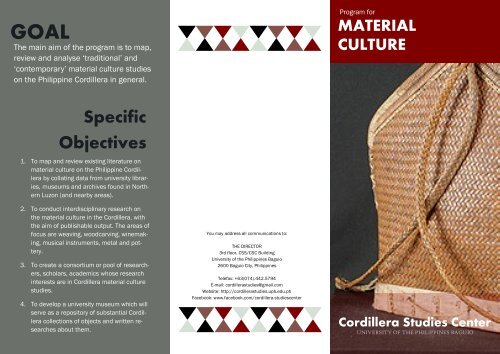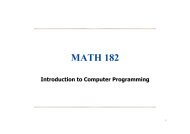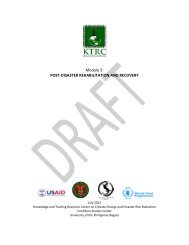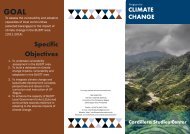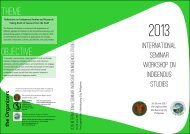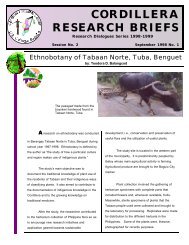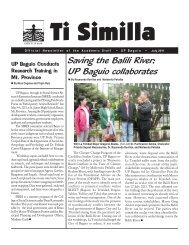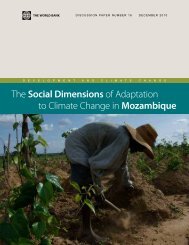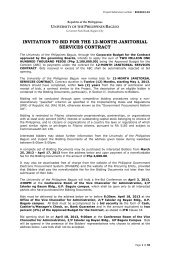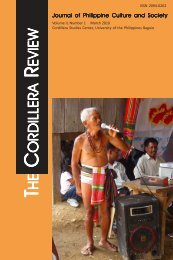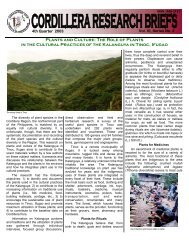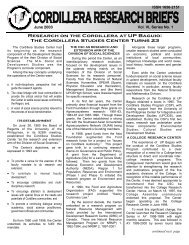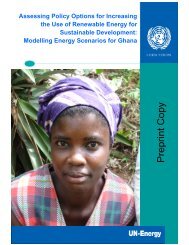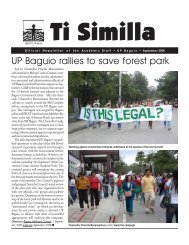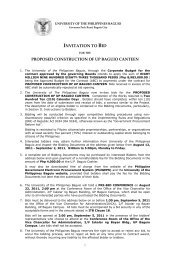Material Culture - Cordillera Studies Center
Material Culture - Cordillera Studies Center
Material Culture - Cordillera Studies Center
You also want an ePaper? Increase the reach of your titles
YUMPU automatically turns print PDFs into web optimized ePapers that Google loves.
GOAL<br />
The main aim of the program is to map,<br />
review and analyse ‘traditional’ and<br />
‘contemporary’ material culture studies<br />
on the Philippine <strong>Cordillera</strong> in general.<br />
Program for<br />
MATERIAL<br />
CULTURE<br />
Specific<br />
Objectives<br />
1. To map and review existing literature on<br />
material culture on the Philippine <strong>Cordillera</strong><br />
by collating data from university libraries,<br />
museums and archives found in Northern<br />
Luzon (and nearby areas).<br />
2. To conduct interdisciplinary research on<br />
the material culture in the <strong>Cordillera</strong>, with<br />
the aim of publishable output. The areas of<br />
focus are weaving, woodcarving, winemaking,<br />
musical instruments, metal and pottery.<br />
3. To create a consortium or pool of researchers,<br />
scholars, academics whose research<br />
interests are in <strong>Cordillera</strong> material culture<br />
studies.<br />
4. To develop a university museum which will<br />
serve as a repository of substantial <strong>Cordillera</strong><br />
collections of objects and written researches<br />
about them.<br />
You may address all communications to:<br />
THE DIRECTOR<br />
3rd floor, CSS/CSC Building<br />
University of the Philippines Baguio<br />
2600 Baguio City, Philippines<br />
Telefax: +63(074).442.5794<br />
E-mail: cordillerastudies@gmail.com<br />
Website: http://cordillerastudies.upb.edu.ph<br />
Facebook: www.facebook.com/cordillera.studiescenter<br />
<strong>Cordillera</strong> <strong>Studies</strong> <strong>Center</strong><br />
UNIVERSITY OF THE PHILIPPINES BAGUIO
Background and<br />
Rationale<br />
Even with the rich material culture in the<br />
<strong>Cordillera</strong> region, there is no systematic<br />
examination of the studies done on<br />
material culture. Most of the studies and<br />
published literature have been focused on<br />
other indigenous institutions such as kinship,<br />
religious life, marriage,<br />
autonomy, political systems and others<br />
(Tolentino 2012).<br />
Studying the material object can lead to the<br />
understanding of the different facets of the<br />
social, economic, political<br />
elements present among indigenous peoples.<br />
Furthermore, by studying culture and<br />
encouraging material culture<br />
research […], we can better understand<br />
both social structures and larger<br />
systemic dimensions of culture, human<br />
action and meaning. Objects might be seen<br />
then, as a crucial link between<br />
social and economic structures, and the<br />
individual actor.<br />
What is material culture<br />
The term ‘material culture’ emphasizes<br />
how apparently inanimate things within<br />
the environment act on people and are<br />
acted upon by people, for the purposes of<br />
carrying out social functions, regulating<br />
social relations and giving symbolic meaning<br />
to human activity (Woodward 2007:3).<br />
Program<br />
Components<br />
Research and Publication<br />
The primary concern of this component is to<br />
assess on the extent of what researches have<br />
been done in the material culture of the<br />
<strong>Cordillera</strong>. A comprehensive analysis of all<br />
these literature will help identify the gaps, and<br />
areas that heed attention for research.<br />
Curriculum/Instruction<br />
The main objective of this component would be<br />
to determine the extent to which material<br />
culture studies and the methodologies of<br />
studying them can actually and potentially be<br />
taught and discussed in the curriculum.<br />
Networking through University-<br />
Community Partnerships<br />
By this component, producers of material culture<br />
in local communities become co-producers<br />
and authors of knowledge. In this way,<br />
indigenous peoples are empowered with their<br />
contribution to material culture studies in the<br />
<strong>Cordillera</strong> region,<br />
Museum Building<br />
This component shall be the repository of<br />
researches on material culture complemented<br />
with the objects being studied.<br />
The Core Team<br />
Prof. Analyn V. Salvador-Amores, Ph.D.<br />
Department of Social Anthropology<br />
and Psychology<br />
Prof. Anna Christie V. Torres, Ph.D.<br />
Department of Language and Literature<br />
Prof. Ruth Tindaan<br />
Department of Language and Literature<br />
Mr. Scott Saboy<br />
Department of Language and Literature<br />
Mr. Jerry Bangcawayan<br />
Department of Social Anthropology<br />
and Psychology<br />
Ms. Cristina Villanueva<br />
Research, Extension and Professional<br />
Staff<br />
Photo credit:<br />
Cabatuan, Zer S. 2012. P2030435. [Photograph]. Retrieved from http://www.flickr.com/<br />
photos/webzer/6863478355/in/set-72157629287300485/<br />
Works cited:<br />
Tolentino, D. (2012). “Making artifacts speak: the study of material culture in the <strong>Cordillera</strong>,<br />
1980-2010,” CSC Jubilee Lecture, July 26, 2012, CSS-AVR Baguio City, Philippines.<br />
Woodward, I. (2007). Understanding material culture. London: Sage Publications.


